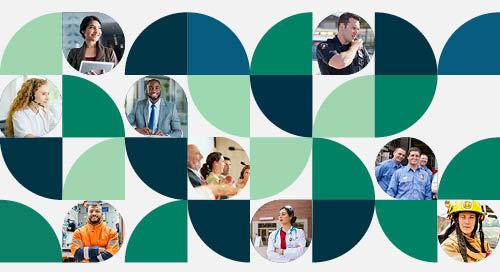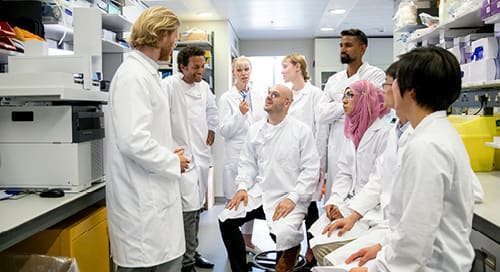When Blanchard’s vice president of applied learning, Dr. Vicki Halsey, asks senior leaders what percent of their people are peak performers, they say only about 10%. Halsey says part of the problem is that leaders spend more time evaluating talent than they do developing it.
“So that means nine out of ten people are not necessarily successful on the different tasks you need your people to do. That won’t cut it in today’s job market and our ever-changing work environment. We need to find a way to keep our best talent growing and get our new talent up to speed quickly.”
Halsey’s recommendation? Bake learning and development into your culture.
“When people first start a job, they are working on a lot of new tasks and goals that they are excited about but don't know how to do yet. That excitement can quickly dissipate if we don’t paint a clear picture of success and build amazing training programs that help people leverage their transferable skills.
“Obviously, we need to onboard them. But new hires also need to know there are people who care to develop them in the way they best learn.”
Guiding People through Disillusionment
Halsey cautions leaders to be careful with their new hires—and to be accessible while they are learning.
“Any time people are learning, it’s important to recognize that disillusionment is a natural stage of development everyone goes through. As a leader, you need to take the emotional stigma out of the equation,” says Halsey.
Halsey points to Blanchard’s SLII® leadership development model, which shows that people go through four distinct learning stages when working on any task or goal. The model starts with Enthusiastic Beginner when a person is new to a task, then moves to Disillusioned Learner when reality sets in.
“From an employee’s standpoint, disillusionment is ‘Wow, there's just too much information. I'll never be able to do this.” From a leader’s standpoint, it’s ‘I can’t believe they still don’t get it. I did this fabulous teaching. They should be perfect at it.’
Halsey encourages leaders to stay close to their people throughout this predictable learning curve.
“As a leader, you need to stay close and know that even if you provided an amazing orientation package and the instructional design was fabulous, new hires are still going to have a moment where they're overwhelmed.
“It's difficult to change your brain, which is what you're doing when you're learning something new,” says Halsey. “It really is important for managers and direct reports to understand that everyone goes through these natural stages of development. You don’t want people hitting the disillusionment stage, giving up, and thinking, ‘I don't have what it takes.’
“Instead, you want them to think, “Wait a minute, this is that second stage of development my manager just taught me. I need to figure out where I am stuck. Who is the best person to help me?”
That’s a powerful question, says Halsey, and suggests this is the time to bring in experienced team members to help. Seasoned employees are a great source of expertise. This is also a great time to begin building an inclusive community and a culture of learning that is so critical to organizational and team success.
“Lack of growth opportunities is one of the biggest reasons experienced talent leaves organizations,” says Halsey. “Enlist your highly experienced talent into the process of teaching others how to do tasks using the method that currently drives success. It’s a great way to create connection and share best practices.
“Do an analysis of your current team. Choose people who are really good at what they do to teach a skill to a new person. It might be different people teaching that person for different tasks. By doing this, you've actually figured out who's the best person to help drive success in this new hire while introducing the person to their team member support system.
“And by the way, what are you doing for the new person? You're building a community where they feel like they can thrive and unleash their gifts with your organization. They see there are people who care about them—and not just one person, because you are leveraging the skills of your entire team to help this new person shine.”
Move from Assessment to Development
“Early in my career, I vividly remember being told that you need to assess your people: who are your good people (or potentially good people) and who are the ones that you may have to help find another organization?
“When you learn the SLII® development model, you realize that everyone can develop to a higher level of performance with the right leadership approach. All of a sudden, your mind now is focused on ‘what do my best and brightest currently do and how can I duplicate that in others?’
“Recently, I was working with the chief legal folks at a large financial company. Fifteen people were sitting around a table and brainstorming the tasks they were challenged with and the time pressures they faced to be more responsive to their internal customers. One of their teammates was known for getting his work done and getting information back to everyone quickly. At one point several of them turned to him and asked him how he did it. He told them, ‘I use this little one-page worksheet to sketch out what people need and what my initial response will be. It helps me organize my thoughts and get a response back to people.’
“Within a minute, fourteen people stood up, went over and looked at his computer, exclaiming ‘Oh my gosh, would you send me that to me?’ They all knew he had been repeatedly successful, but no one knew how.
“Let's start having people share like that more often! It makes everyone smarter—including your new hires—and drives higher levels of performance for all. It also creates a community of recognition, appreciation, and valuing contribution, which is what keeps people staying with the organization, learning faster, and endorsing the organization.”
Creating a Culture of Development, Growth, and Inspiration
“So many new people quit because they aren't getting taught in a way that resonates with their soul and helps them be successful. Many people feel isolated. This is a way of learning and onboarding that helps everyone contribute what they know and creates bonds with people. That’s a big difference from a culture that sorts and assesses,” says Halsey.
“In today’s world, there needs to be a real focus on success and what's driving it. You need a plan to help ramp up new hires to actually do that. So how do we leverage our existing people to reduce the time to performance by leveraging the gifts of people who are currently knocking it out of the park?
“We all need to constantly develop and learn new skills that move everyone forward. With the SLII® leadership model, we get clear on the skills that are needed and we can identify people who are already performing well in that role. Then we can teach other people how to perform like that and be willing to be there through the coaching and the supporting. It’s a great way to build a positive, generative type of environment.”
____________________________________________________________________
Would you like to learn more about SLII® and how it can help you create a culture of learning and development? Join us for a free webinar!
Creating a Culture of Learning and Development
Wednesday, October 6, 2021
7:00 a.m. Pacific Time / 10:00 a.m. Eastern Time / 3:00 p.m. UK Time
With a tight labor market and an ever-changing business environment, the ability to ramp up the performance of new hires and retain the motivation and performance of your top people is key. In this webinar, Dr. Vicki Halsey, vice president of applied learning at The Ken Blanchard Companies, shares best practices on:
- Leading in today’s changing work environment—what people want and need to perform at a high level
- The 3 Skills of SLII®—how goal setting, diagnosing, and matching brings out the best in people
- Getting started—putting ideas into practice at an individual, team, and organizational level
Don’t miss this opportunity to create a welcoming and learner-focused environment for your new hires and a growth, recognition, and meaning-filled environment for your top talent.
About the Author
More Content by David Witt













